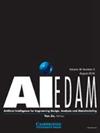Evolutionary layout design synthesis of an autonomous greenhouse using product-related dependencies
IF 2.3
3区 工程技术
Q3 COMPUTER SCIENCE, ARTIFICIAL INTELLIGENCE
Ai Edam-Artificial Intelligence for Engineering Design Analysis and Manufacturing
Pub Date : 2020-09-21
DOI:10.1017/S0890060420000384
引用次数: 3
Abstract
Abstract The development of autonomous greenhouses has caught the interest of many researchers and industrial considering their potential of offering an optimal environment for the growth of high-quality crops with minimum resources. Since an autonomous greenhouse is a mechatronic system, the consideration of its subsystem (e.g. heating systems) and component (e.g. actuators and sensors) interactions early in the design phase can ease the product development process. Indeed, this consideration could shorten the design process, reduce the number of redesign loops, and improve the performance of the overall mechatronic system. In the case of a greenhouse, it would lead to a higher quality of the crops and a better management of resources. In this work, the layout design of a general autonomous greenhouse is translated into an optimization problem statement while considering product-related dependencies. Then, a genetic algorithm is used to carry out the optimization of the layout design. The methodology is applied to the design of a fully autonomous greenhouse (45 cm × 30 cm × 30 cm) for the growth of plants in space. Although some objectives are conflictual, the developed algorithm proposes a compromise to obtain a near-optimal feasible layout design. The algorithm was also able to optimize the volume of components (occupied space) while considering the energy consumption and the overall mass. Their respective summed values are 2844.32 cm3, which represents 7% of the total volume, 5.86 W, and 655.8 g.利用产品相关依赖关系的自主温室进化布局设计综合
摘要自主温室的开发引起了许多研究人员和工业界的兴趣,因为它们有潜力以最少的资源为优质作物的生长提供最佳环境。由于自主温室是一个机电一体化系统,在设计阶段早期考虑其子系统(如加热系统)和组件(如致动器和传感器)的相互作用可以简化产品开发过程。事实上,这种考虑可以缩短设计过程,减少重新设计循环的数量,并提高整个机电系统的性能。在温室的情况下,它将导致更高质量的作物和更好的资源管理。在这项工作中,在考虑产品相关依赖性的同时,将通用自主温室的布局设计转化为优化问题陈述。然后,利用遗传算法对布局设计进行优化。该方法用于设计一个完全自主的温室(45cm×30cm×30cm),用于植物在太空中的生长。尽管有些目标是矛盾的,但所开发的算法提出了一种折衷方案,以获得接近最优的可行布局设计。该算法还能够在考虑能耗和总质量的同时优化组件的体积(占用空间)。它们各自的合计值为2844.32 cm3,代表总体积的7%,5.86 W和655.8 g。
本文章由计算机程序翻译,如有差异,请以英文原文为准。
求助全文
约1分钟内获得全文
求助全文
来源期刊
CiteScore
4.40
自引率
14.30%
发文量
27
审稿时长
>12 weeks
期刊介绍:
The journal publishes original articles about significant AI theory and applications based on the most up-to-date research in all branches and phases of engineering. Suitable topics include: analysis and evaluation; selection; configuration and design; manufacturing and assembly; and concurrent engineering. Specifically, the journal is interested in the use of AI in planning, design, analysis, simulation, qualitative reasoning, spatial reasoning and graphics, manufacturing, assembly, process planning, scheduling, numerical analysis, optimization, distributed systems, multi-agent applications, cooperation, cognitive modeling, learning and creativity. AI EDAM is also interested in original, major applications of state-of-the-art knowledge-based techniques to important engineering problems.

 求助内容:
求助内容: 应助结果提醒方式:
应助结果提醒方式:


